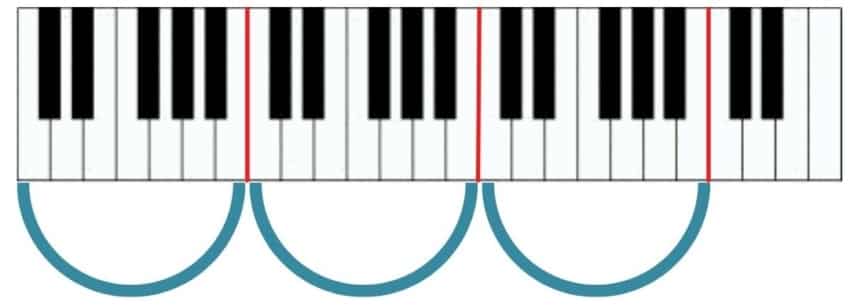Have you ever looked at a piano and wondered to yourself, “Why are some of these keys white and others black? Who got to decide that?” …While the layout of a piano’s keys may seem random at first glance, there are actually a number of practical reasons for ordering them in this particular way.
Why are piano keys arranged the way they are?
Piano keys are arranged in repeating patterns of white and black keys, patterns that help the pianist more quickly identify notes, scales, and (musical) keys. The 88 keys are broken up into 7 octaves, within which each contain 12 notes separated into two distinct clusters of white and black keys. Breaking the keyboard up in this way helps tremendously when visualizing the piano – a very useful skill to have when it comes to playing!
It makes finding notes easier

Imagine a keyboard made up of entirely white keys – all exactly the same in shape, size, and spacing. If I asked you to identify a C# somewhere in the middle of the keyboard, the only way you could really do it would be to count up from the bottom.
This would take quite some time. Having a group of two black keys, a group of 3 black keys all mixed-in with 7 white keys, helps you find specific notes by breaking the 88-key keyboard into just a few repeating patterns. Visually, this helps pianists a ton and is the main reason why some are able to hop around the keys so seemingly quick and effortless.
The Layout repeats multiple times

Within the seven 12-note octaves of the piano, simpler patterns can be identified to help us navigate our way around the keyboard.
The first pattern we notice is two separate clusters of black and white keys – one with 3 black and 4 white, the other with 2 black and 4 white. This binary pattern is then repeated up the entire piano, visually and mentally simplifying the keyboard a great deal (it’s much easier to memorize 2 sets of 6 notes than one set of 88!)
Scales and Intervals on the Keyboard
The layout of the keyboard can also help us identify patterns among scales and intervals. All instruments are built in favor of (easiest to play) one particular key, and for the piano that key is C major.
Playing all of the white keys starting on any C will give you the C major diatonic scale. Playing only white keys but starting on a note other than C will give you the various modes of C major (Dorian, Phrygian, Lydian, Mixolydian, Aeolian, Locrian).
Starting from C major and working our way around the Circle of Fifths, we can add one black key to the key signature from C-Gb, and then subtract one from B to C. Each (musical) key on the piano contains its own uniquely identifiable pattern of white and black keys that make memorizing the locations of the notes a whole lot easier.
Natural, Sharp and flat keys
Having black and white keys can also help us aurally with identifying and dictating the notes – white keys are “natural”, and black keys are either “sharp” or “flat”, depending on whether the note you’re referencing is a half-step up or down from its respective white key.
For example, the note “F#” can also be referred to as “Gb” – sharp meaning ‘above F’ or flat meaning ‘below G’ – either way, it’s the same note.
Problems & benefits of the current key layout
The keyboard we’ve come to know today is built in favor of C major, accepting the notion that white keys are easier to play than black keys. With the exception of C major, each major key contains its own unique chord shapes and fingerings that need to be learned.
Whereas on an instrument like the guitar, learning a scale in a different key is much easier as you simply move your hand up or down a specific number of frets. However, unlike the guitar you don’t have different hand shapes for different octaves – if you know the shapes for one octave, you know them in every.
Conclusion
Breaking down the 88 keys on a keyboard into smaller, more easily memoizable patterns is what gives us the ability to play music on the piano.
Without it, our brains would have to work impossibly hard to even play the most simple of tunes. The arrangement of black and white keys as they are enables our brain to simplify the piano, freeing up space to focus on the more complex aspects of music (dynamics, rhythm/feel, etc.)
FAQs
Why are pianos missing black keys? In 12-tone western scales, the notes F and C do not have corresponding flats (Fb is just E natural and Cb is B natural). If a keyboard were to be laid out by simply alternating between black and white keys, you would then have white keys that were “flats” and black keys that were “naturals”, leading to a lot of confusion. Maintaining the consistency between white and black keys with natural and sharp/flat notes, respectively, makes quickly identifying the notes much easier.
Who invented the piano keyboard layout? An Italian man named Bartolomeo Cristofori (May 4, 1655 – January 27, 1731) – before him there were other keyboard-based instruments, just not arranged in the way we know today.
